Sauerkraut Recipes: The Gut-Friendly Vegan Superfood You Need to Try
Recipe List
Introduction
Sauerkraut, a fermented cabbage dish, is not just a culinary delight but also a treasure trove of health benefits and plant-based goodness. In this exploration of Sauerkraut and its versatile uses in vegan cuisine, we dive deep into its benefits, nutrition, and the unique challenges and questions surrounding its consumption and cooking.

Sauerkraut Benefits and Nutrition: Sauerkraut is a nutritional powerhouse, rich in probiotics that promote gut health, vitamins C and K, and essential minerals. Its low-calorie content makes it an ideal addition to vegan and diet-conscious meals.
Health and Potential Challenges: While Sauerkraut offers numerous health benefits, it can be an acquired taste due to its tangy and sour profile. Some may find the intense flavors challenging initially. Moreover, proper fermentation and preparation are key to reaping its full probiotic potential.
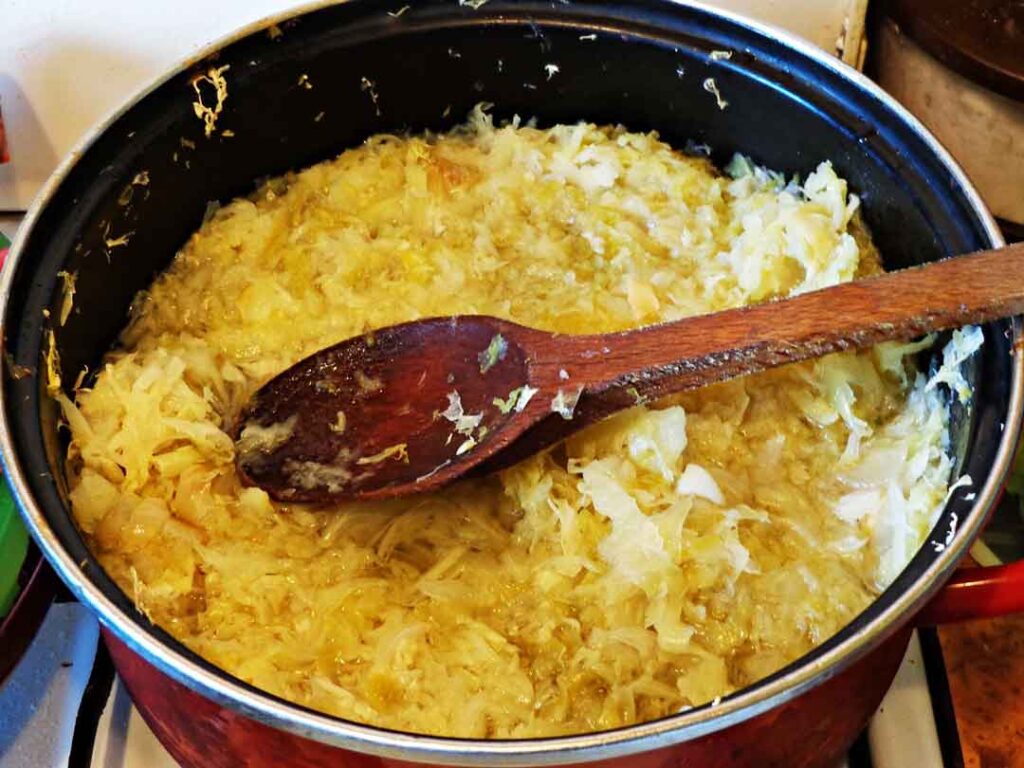
Cooking with Sauerkraut: Sauerkraut’s unique taste and texture make it a versatile ingredient in vegan cooking. However, its bold flavors can sometimes overpower other ingredients, requiring careful balancing in recipes.
Sauerkraut’s Significance for Vegans and Diets: For vegans, Sauerkraut is a valuable addition to their diet as it enhances flavors and provides essential nutrients. It can also be a secret weapon for those on specific diets, offering both taste and health benefits.
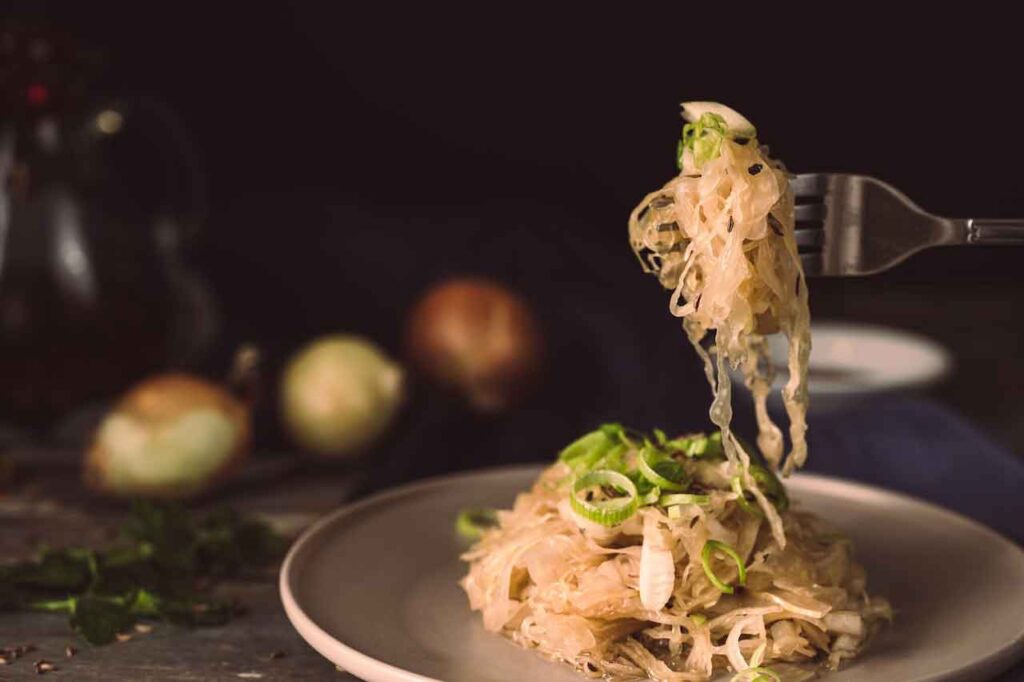
Article Highlights: This article explores Sauerkraut’s benefits, addresses common questions and challenges, and provides practical tips for cooking and incorporating it into vegan and diet-conscious meals. Whether you’re a Sauerkraut enthusiast or a newcomer, this guide will enrich your plant-based culinary journey.
1. Homemade Sauerkraut
Discover the delightful world of plant-based cuisine with our Homemade Sauerkraut recipe. This tangy and crunchy delight is not only a vegan-friendly delight but also a versatile addition to your culinary repertoire. With just two simple ingredients and a few easy steps, you can craft your very own batch of probiotic-rich Sauerkraut. The secret lies in the careful fermentation process, which yields a zesty and slightly sour flavor profile that complements a wide range of vegan dishes. Whether you’re adding it to sandwiches, salads, or bowls, our Homemade Sauerkraut is sure to elevate your plant-based creations to new heights. Embrace the world of vegan flavors and give your taste buds a delectable twist!
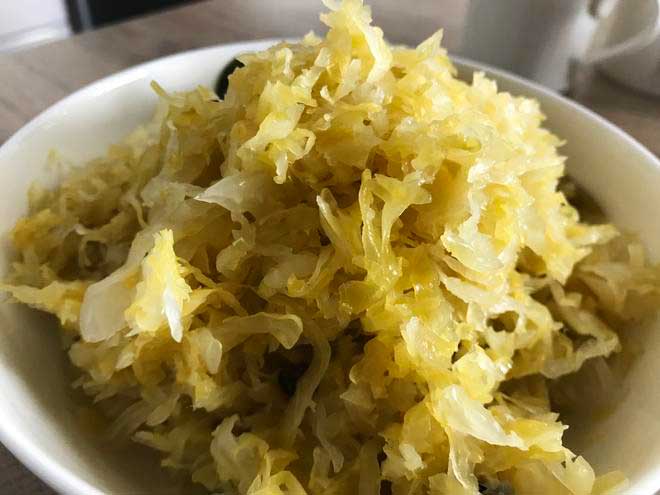
Ingredients:
| Cabbage | 500g |
| Salt | 10g |
| Tools: | Sealable glass container with one-way air vent |
| Small, heavy objects (e.g., small plates, glass jars, etc.) |
Method:
- Wash the cabbage thoroughly and slice it into thin strips.
- Place the cabbage in a regular container and add the salt, mixing it evenly.
- Use your hands to knead and squeeze the cabbage, making it soft. Let it sit for 30 minutes to release its moisture.
- Squeeze out the excess liquid from the cabbage and transfer it to a glass container (save the squeezed-out liquid). Press the cabbage down with your hands and place small, heavy objects on top to prevent it from floating in the liquid.
- Pour the liquid extracted in step 4 back into the glass container, ensuring the cabbage is completely submerged. If the liquid is insufficient, you can add cooled, boiled water.
- Seal the container and let it sit at room temperature, avoiding direct sunlight. After 5 days, your homemade Sauerkraut will be ready.
Summary:
For step 2, it’s better to use iodine-free salt. The salt quantity should be 1-3% of the weight of the cabbage. In step 4, sterilize the glass container in advance by heating it. The container should be large enough so that the cabbage occupies about 70% of its volume, leaving some space. In step 5, make sure the cabbage is completely submerged in the liquid; cabbage exposed to air can spoil. In step 6, if the glass container doesn’t have a one-way air vent, don’t seal the lid too tightly; you can open it once for venting on the third day. The fermentation time is a reference; you may need to extend it if the room temperature is low. After making Sauerkraut, you can remove the weights and store it in the refrigerator. It’s best consumed within 2 months.
2. Sauerkraut Fried Rice Noodles
Indulge in a symphony of flavors with our Sauerkraut Fried Rice Noodles recipe! This delectable plant-based dish marries the bold, tangy notes of Sauerkraut with the delicate textures of rice noodles. The result is a harmonious blend of savory and slightly spicy goodness that’s perfect for vegans and food enthusiasts alike. As you take your first bite, you’ll savor the umami-rich combination of light and dark soy sauces, the subtle kick from the chili pepper, and the tantalizing hint of Sichuan peppercorn oil. This vegan delight is not just a dish; it’s a taste adventure waiting to be explored. Elevate your plant-based culinary experience with Sauerkraut Fried Rice Noodles today!
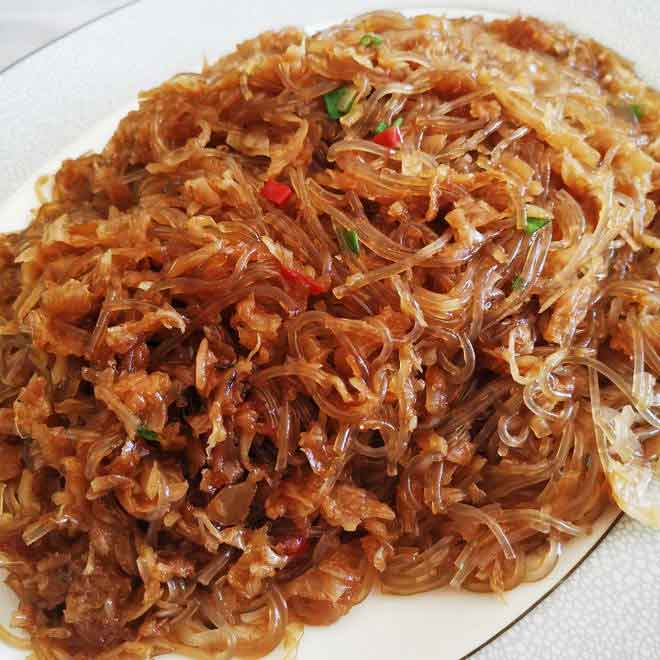
Ingredients:
| Sauerkraut | 450g |
| Rice noodles | 150g |
| Green onions | 1 stalk |
| Small chili pepper | 1 |
| Light soy sauce | 2 tablespoons |
| Dark soy sauce | 1 tablespoon |
| Sichuan peppercorn oil | 1 teaspoon |
| Granulated sugar | 1 teaspoon |
| Cooking oil | 4 tablespoons |
Method:
- Soak the rice noodles until they soften. (Approximately 30 minutes in cold water or about 10 minutes in warm water.)
- Squeeze the Sauerkraut to extract its juice, and set the juice aside.
- Place the rice noodles in a container, add light soy sauce, dark soy sauce, and the juice from the Sauerkraut. Stir well and let it sit for 10 minutes.
- Heat the cooking oil in a pan until it begins to smoke. Add chopped green onions and minced chili pepper, stir-fry until fragrant.
- Add the Sauerkraut, stir-fry for 15 seconds. Cover the pan and heat for 30 seconds.
- Add the rice noodles and the sauce from the noodles, stir-fry for 2 minutes. Add Sichuan peppercorn oil and granulated sugar, stir well. Cover the pan, reduce the heat to medium, and let most of the liquid evaporate from the sauce.
- Serve the Sauerkraut fried rice noodles. Enjoy!
Summary:
In step 6, you can use sesame oil instead of Sichuan peppercorn oil according to your personal taste. If the sauce seems too dry during stir-frying and the rice noodles are too dry, you can add a small amount of water.
3. Potato and Sauerkraut Stew
This Sauerkraut recipe will take you to experience the heartwarming flavors of our Potato and Sauerkraut Stew, a wholesome and hearty addition to your plant-based culinary repertoire. This delightful vegan dish brings together the zesty tanginess of Sauerkraut with the comforting richness of tender potato strips. As you savor each bite, you’ll be greeted by a symphony of flavors, from the aromatic ginger and fragrant Sichuan peppercorns to the earthy depth of shiitake mushroom powder. The star anise adds a subtle hint of sweetness, while the subtle notes of salt tie everything together. Whether you’re a seasoned vegan cook or just exploring plant-based options, our Potato and Sauerkraut Stew is a delectable journey you won’t want to miss.
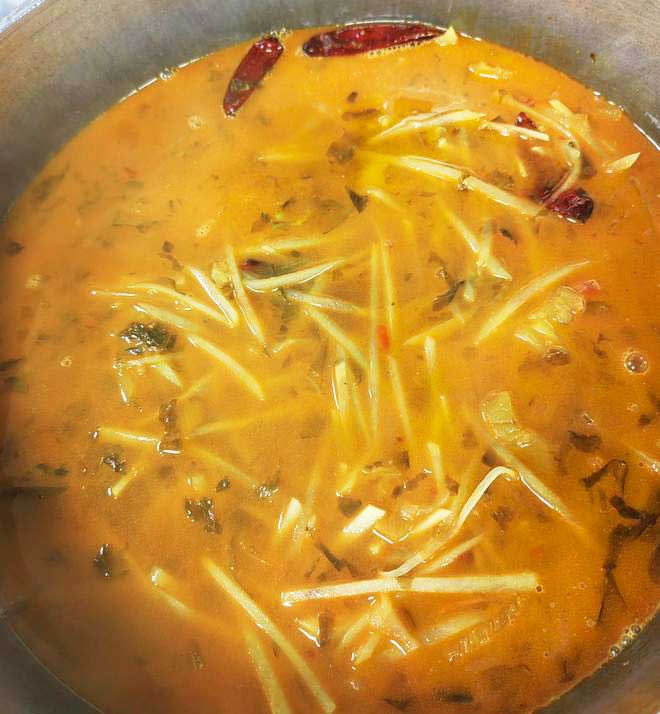
Ingredients:
| Sauerkraut | 300g |
| Potato | 1 |
| Green onion | 1 stalk |
| Ginger | 10g |
| Sichuan peppercorns | 15 |
| Star anise | 1 |
| Shiitake mushroom powder | 1 teaspoon |
| Salt | 2g |
| Oil | 2 tablespoons |
| Water | Enough to submerge the sauerkraut (approximately 1000ml) |
Method:
- Squeeze out the excess moisture from the Sauerkraut.
- Wash and peel the potato, then cut it into strips. Soak the potato strips in water for 15 minutes. Drain and set aside.
- Chop the green onion, slice the ginger, and clean the star anise and Sichuan peppercorns.
- In a pot, heat the oil until it starts to smoke, then add the Sichuan peppercorns. Reduce the heat to low and fry the Sichuan peppercorns until fragrant. Remove and discard the peppercorns.
- Add the chopped green onion and sliced ginger to the pot, stir-fry until fragrant.
- Add the Sauerkraut and stir-fry for 2 minutes.
- Add the potato strips and stir-fry for 1 minute.
- Pour in the water, add the star anise, salt, and shiitake mushroom powder. Stir well, bring to a boil over high heat. Reduce the heat to medium and continue simmering for 10 minutes.
- Serve the Potato and Sauerkraut Stew. Enjoy!
Summary:
The cooking time in step 7 is a reference; adjust it according to your preferred texture. If you want a softer texture for the Sauerkraut, you can extend the cooking time. If the potato slices are thicker, you may also need to increase the cooking time. In step 8, you can add white pepper powder and cilantro according to your personal taste.
4. Sauerkraut Stir-Fried Potato Strips
This Sauerkraut recipe will take you to experience the perfect fusion of flavors with our Sauerkraut Stir-Fried Potato Strips – a vegan masterpiece that tantalizes your taste buds! This sensational dish combines the earthy richness of potato strips with the tangy twist of Sauerkraut, creating a symphony of textures and tastes. As you take your first bite, you’ll be greeted by the savory notes of garlic, ginger, and dried red chili peppers, enhanced by the umami depth of soy sauce. A touch of sesame oil adds a delightful nutty essence, while the green onions provide a fresh contrast. It’s a culinary adventure that showcases the versatility and deliciousness of plant-based cooking. Dive into a world of flavor with our Sauerkraut Stir-Fried Potato Strips and elevate your vegan dining experience!
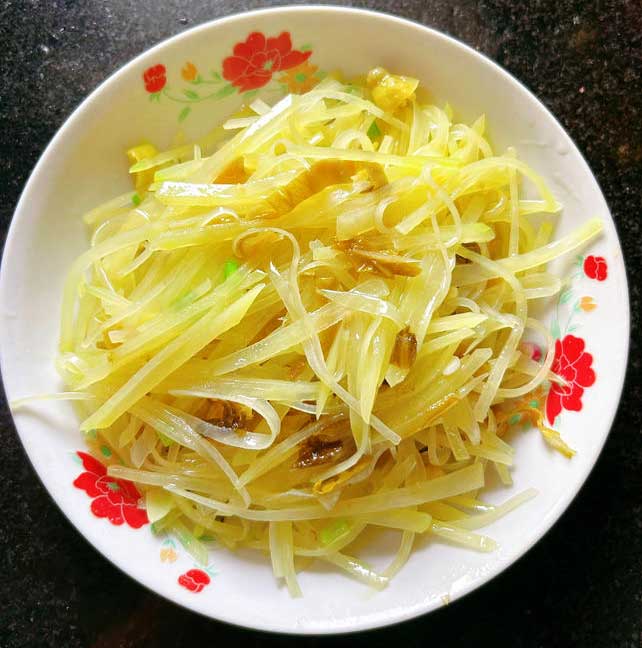
Ingredients:
| Sauerkraut | 150g |
| Potato | 1 |
| Green onions | 2 stalks |
| Garlic cloves | 2 |
| Ginger | 10g |
| Dried red chili peppers | 2 |
| Soy sauce | 1 tablespoon |
| Salt | 1g |
| Granulated sugar | 2g |
| Sesame oil | 1 teaspoon |
| Cooking oil | 2 tablespoons |
Method:
- Wash and peel the potato, then cut it into thin strips. Soak the potato strips in water for 10 minutes. Drain and remove excess moisture.
- Place the potato strips in a container, add the Sauerkraut, mix well, and marinate for 15 minutes.
- Prepare the ingredients: Separate the white and green parts of the green onions and finely chop them. Slice the garlic cloves. Cut the ginger into thin strips. Cut the dried red chili peppers into small pieces.
- In a pan, heat the cooking oil until it starts to smoke, then add the white parts of the green onions, garlic, ginger, and dried red chili peppers. Stir-fry until fragrant.
- Add the potato strips and Sauerkraut, stir-fry for 2 minutes.
- Add salt, granulated sugar, and soy sauce, stir-fry for 1.5 minutes.
- Add sesame oil and the green parts of the green onions, stir-fry for 30 seconds, and it’s ready.
Summary:
In this recipe, combining the potato strips and Sauerkraut in advance will take longer to cook than stir-frying the potato strips separately.
5. Spicy and Sour Sauerkraut Soup
Delight your taste buds with our Spicy and Sour Sauerkraut Soup, a tantalizing fusion of flavors that celebrates the bold and the tangy! This delightful vegan creation combines the zesty kick of Sauerkraut with the warm embrace of ginger and green onions. A hint of spice from dried red chili peppers adds excitement, while shiitake mushroom powder infuses rich umami notes. As you savor each spoonful, the interplay of sourness and sweetness, heightened by a pinch of salt and granulated sugar, dances on your palate. It’s a flavorful journey that showcases the versatility of plant-based cuisine. Spice up your meals with our Spicy and Sour Sauerkraut Soup and make your vegan dining experience unforgettable!

Ingredients:
| Sauerkraut | 300g |
| Green onion | 1 stalk |
| Ginger | 10g |
| Salt | 3g |
| Granulated sugar | 4g |
| Shiitake mushroom powder | 4g |
| Dried red chili peppers | 3 |
| Oil | 2.5 tablespoons |
| Water | 1000ml |
Method:
- Squeeze excess moisture from the Sauerkraut. (Taste the Sauerkraut; if you find the sourness too strong, you can rinse it with water and then squeeze out the moisture.)
- Finely chop the green onion. Slice the ginger into thin strips.
- Heat a pan and add the dried red chili peppers. Stir-fry until the chili peppers turn brown. Remove the dried red chili peppers, then chop them finely (or grind them).
- In the same pan, add oil and heat it until it starts to smoke. Add the chopped green onion and ginger, stir-fry until fragrant.
- Add the Sauerkraut and stir-fry for 2 minutes.
- Add water, shiitake mushroom powder, salt, and granulated sugar. Stir well. Bring to a boil over high heat, then reduce the heat to medium and continue simmering for 10 minutes.
- Add the chopped dried red chili peppers, stir well, and it’s ready.
Summary:
The cooking time in step 6 is a reference; if you prefer a softer texture for the Sauerkraut, you can extend the cooking time. Adjust the amount of salt and granulated sugar according to your personal taste; salt accentuates the sourness of the Sauerkraut soup, while sugar balances the acidity.



